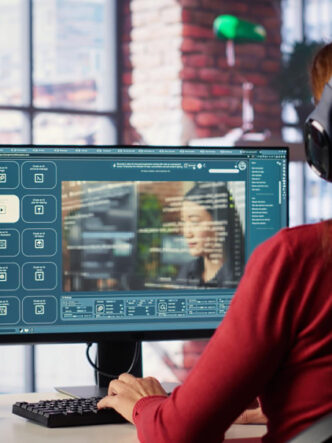The dynamics of communication within organizations are changing. Modern internal communication tools are helping to cut through the noise and ensure that important communication doesn’t fall through the gaps. Video stands out as the preferred means of communication for many reasons. Employees are more likely to watch videos than read documents or emails. Recorded video messages are becoming common in the workplace. One of the first steps when using videos is to decide where they should live so employees can have easy access to them. A dedicated employee video portal provides the solution.

What is an employee video portal?
An employee video portal is a centralized platform for hosting and managing internal video content accessible only to employees. It creates a flexible environment where you can accommodate videos for different purposes and organize them as you see fit. You can use videos in this central location to train and educate employees in a cost-effective way. Videos offer one of the best ways to keep employees engaged and this makes them more productive.
The types of content you can have in such a portal include onboarding and training videos, company updates, knowledge-sharing videos, and more. For example, onboarding videos can save HR from having to repeatedly go over company policies and procedures with new hires.
The portal creates an environment in which teams can collaborate and develop healthy connections. This can foster rapid responses to problems and more innovation. Analytics allow you to find out how employees interact with videos so you can make improvements where necessary.
Benefits of using an employee video portal
Communicating with employees using traditional means such as emails or memos is often ineffective in engaging them. Using internal communication videos can solve this problem. With an employee video portal for corporate video management, your organization can save time, effort, and money.
Enhance training and development
A video portal can facilitate effective employee training and continuous learning. Employees can access a library of recorded training sessions. They don’t have to rely on trainers but can learn independently which reduces training costs. Employee training videos can cover many areas from basic skills training to management, compliance, and security training. A video knowledge base offers employees consistent training to refresh their knowledge, gain new skills, and stay up to date with industry trends.
Improve communication
Video portals improve internal communication by making important information easily accessible. Collaborating through a video portal can replace lengthy meetings and long email threads. Team members can communicate spontaneously which can lead to better relationships and speedy solutions to issues. HR professionals can use a video portal to share all kinds of information with employees, such as annual leave procedures. Live streaming sessions can help employees to speak to managers and communicate their thoughts.
Increase engagement
Using video for employee engagement makes sense as it’s a visually exciting medium. They learn more from video and retain it better than from text alone. Video features such as quizzes, polls, annotations, transcripts, captions, etc. make videos more interactive. Internal video communication can empower employees and create more synergy across departments.
Offer consistency and standardization
It’s important to deliver consistent messages and training across the organization. With internal video hosting in a central location, there are no longer information silos. Centralizing key information such as training materials helps to promote consistency throughout the organization.
Provide easy access and convenience
On-demand access to important resources can save time and improve productivity. For example, new hires can access onboarding videos at a time and place that works for them so they can quickly get up to speed. Employees can easily record their webcams and screens to share video messaging that helps other employees to learn.

What to look for in an employee video portal
A corporate video platform that cultivates purposeful communication helps to foster a growth-oriented environment. A dedicated employee video portal needs the following features to serve this purpose.
User-friendly interface
The interface should be intuitive and easy to navigate. Employees should find it easy to create, upload, manage, and share videos.
Security and privacy
A secure video portal needs essential security features such as user authentication, role-based access control, and data encryption. Secure video hosting is necessary because the video portal will contain confidential information that only authorized users should be able to access.
Customization
You should be able to customize the portal to reflect your organization’s branding and organizational structure. This helps to foster a positive internal brand image and a cohesive company culture.
Integration
A video portal should integrate seamlessly with your existing HR, LMS, and communication tools. Integration helps to promote real-time collaboration and streamlining of workflows.
Analytics
Advanced video analytics help you to track video performance, engagement, and employee progress. For example, you can use video data to track the progress of an employee through a specific playlist of training videos and intervene if the employee appears to be struggling.
Using CincoTube for employee video portal
CincoTube is a powerful, secure, and customizable video hosting platform. It is similar to YouTube but you have complete control over your videos. You can create your own branded Tube that’s public or access-restricted. Use it for live-streaming, video-on-demand (VOD), or podcasts. It’s also an image hosting platform and you can upload and manage all your images in a centralized library. You can easily upload, organize, store, share, and monitor your videos using CincoTube. Videos are responsive across all devices so employees can watch them from anywhere at any time and on whatever device they want to use.
Security features
By using CincoTube, you can communicate internally without worrying about confidential information leaking. Advanced security measures include end-to-end video encryption, right-click protection, and SSO. Extensive permission settings help to protect your valuable assets.
Customizable interface
If you go to Cincopa home page, you will find CIncoTube under products and learn how to create your own branded video hub. You can customize your player and video library to reinforce your brand identity.
Seamless integration
CincoTube integrates with popular HR, LMS, and communication tools. With Zoom integration, all your web meetings, conferences, and webinar recordings are preserved. Elevate your workflow by integrating with Slack. With Cincopa’s LMS plugin, you can create media-rich e-learning web portals.
Advanced analytics
CincoTube’s robust analytics tools provide insights into video engagement, viewership, and training effectiveness. With real-time reporting and heatmaps, you can gain more insights into what keeps employees engaged.
User experience
Both administrators and users can easily upload, manage, and access video content. A video messaging screen recorder extension allows employees to capture every detail on a screen. They can add annotations, and share recordings to make collaboration a cinch.
Conclusion
A dedicated video employee portal can provide a solution for your organization if you make use of many internal videos. A video portal like CincoTube can help you recruit, onboard, and train employees. It can streamline your processes, facilitate communication, enhance security, and decrease costs. Consider implementing an employee video portal to improve your communication and training efforts.








